Geochemistry and Geochronology of W-Mineralized Fourque Granodiorite Intrusion, Pyrenean Axial Zone, Southern France
Abstract
1. Introduction
2. Geological Context
2.1. Regional Geological Context
2.2. Local Geological Context and Petrographic Study
3. Sampling and Analytical Methods
3.1. Sampling
3.2. Petrography and Thin Section Analyses
3.3. Whole-Rock Major and Trace Element Analyses
3.4. LA-ICP-MS Zircon U–Pb and Trace Elements
4. Analytical Results
4.1. Whole-Rock Major and Trace Element Composition
4.2. Zircon U–Pb Geochronology
4.3. Zircon Trace Elements
5. Discussions
5.1. Geochronological Framework
5.2. Granite and Magma Type and Classification
5.3. Tectonic Context
6. Conclusions
Supplementary Materials
Author Contributions
Funding
Data Availability Statement
Acknowledgments
Conflicts of Interest
References
- Schulmann, K.; Catalán, J.R.M.; Lardeaux, J.M.; Janoušek, V.; Oggiano, G. The Variscan Orogeny: Extent, Timescale and the Formation of the European Crust; Geological Society, London, Special Publications: London, UK, 2014; Volume 405, pp. 1–6. [Google Scholar] [CrossRef]
- Kroner, U.; Mansy, J.L.; Mazur, S.; Aleksandrowski, P.; Hann, H.P.; Huckriede, H.; Lacquement, F.; Lamarche, J.; Ledru, P.; Pharaoh, T.C.; et al. Variscan tectonics. In The Geology of Central Europe; The Geological Society: London, UK, 2008; Volume 1, pp. 599–664. [Google Scholar]
- Derre, C. Relations chronologiques entre la mise en place du granite de Salau (Haute vallée du Salat, Pyrénées Ariégeoises) et les déformations du Paléozoïque de la région. C.R. Acad. Sc. Fr. 1973, 277, 1279. [Google Scholar]
- Guy, B.; Sheppard, S.; Fouillac, A.; Le Guyader, R.; Toulhoat, P.; Fonteilles, M. Geochemical and isotope (H, C, O, S) studies of barren and tungsten-bearing skarns of the French Pyrenees. In Mineral Deposits Within the European Community; Springer: Cham, Switzerland, 1988; pp. 53–75. [Google Scholar]
- Raimbault, L.; Kaelin, J.-L. Pétrographie et géochimie de la granodiorite de La Fourque (gisement de scheelite de Salau, Pyrénées, France). Bull. Minéral. 1987, 110, 633–644. [Google Scholar]
- Poitrenaud, T. Le Gisement Périgranitique à Tungstène et or de Salau (Pyrénées, France), Histoire Polyphasée d’un Système Minéralisé Tardi-Varisque. Ph.D. Thesis, Université d’Orléans, Orléans, France, 2018. [Google Scholar]
- Balan, H. Exploitation, post-mining, re-exploration? New projects for former French metal mines. Extr. Ind. Soc. 2021, 8, 104–110. [Google Scholar] [CrossRef]
- Denèle, Y.; Laumonier, B.; Paquette, J.-L.; Olivier, P.; Gleizes, G.; Barbey, P. Timing of granite emplacement, crustal flow and gneiss dome formation in the Variscan segment of the Pyrenees. In The Variscan Orogeny: Extent, Timescale and the Formation of the European Crust; Geological Society, London, Special Publications: London, UK, 2014; Volume 405, pp. 265–287. [Google Scholar] [CrossRef]
- Aguilar, C.; Liesa, M.; Štípská, P.; Schulmann, K.; Muñoz, J.A.; Casas, J.M. P–T–t–d evolution of orogenic middle crust of the Roc de Frausa Massif (Eastern Pyrenees): A result of horizontal crustal flow and Carboniferous doming? J. Metamorph. Geol. 2015, 33, 273–294. [Google Scholar] [CrossRef]
- Liesa, M.; Aguilar, C.; Castro, A.; Gisbert, G.; Reche, J.; Muñoz, J.A.; Vilà, M. The role of mantle and crust in the generation of calc-alkaline Variscan magmatism and its tectonic setting in the Eastern Pyrenees. Lithos 2021, 406–407, 106541. [Google Scholar] [CrossRef]
- Vergés, J.; Millán, H.; Roca, E.; Muñoz, J.A.; Marzo, M.; Cirés, J.; Bezemer, T.D.; Zoetemeijer, R.; Cloetingh, S. Eastern Pyrenees and related foreland basins: Pre-, syn-and post-collisional crustal-scale cross-sections. Mar. Pet. Geol. 1995, 12, 903–915. [Google Scholar]
- Esteban, J.J.; Aranguren, A.; Cuevas, J.; Hilario, A.; Tubía, J.M.; Larionov, A.; Sergeev, S. Is there a time lag between the metamorphism and emplacement of plutons in the Axial Zone of the Pyrenees? Geol. Mag. 2015, 152, 935–941. [Google Scholar] [CrossRef]
- Rosenbaum, G.; Lister, G.S.; Duboz, C. Relative motions of Africa, Iberia and Europe during Alpine orogeny. Tectonophysics 2002, 359, 117–129. [Google Scholar]
- Handy, M.R.; Schmid, S.M.; Bousquet, R.; Kissling, E.; Bernoulli, D. Reconciling plate-tectonic reconstructions of Alpine Tethys with the geological–geophysical record of spreading and subduction in the Alps. Earth-Sci. Rev. 2010, 102, 121–158. [Google Scholar] [CrossRef]
- Vergés, J.; Fernàndez, M.; Martìnez, A. The Pyrenean orogen: Pre-, syn-, post-collisional evolution. J. Virtual Explor. 2002, 8, 55–74. [Google Scholar]
- Grool, A.R.; Ford, M.; Vergés, J.; Huismans, R.S.; Christophoul, F.; Dielforder, A. Insights into the crustal-scale dynamics of a doubly vergent orogen from a quantitative analysis of its forelands: A case study of the Eastern Pyrenees. Tectonics 2018, 37, 450–476. [Google Scholar]
- Vissers, R.L.M. Variscan extension in the Pyrenees. Tectonics 1992, 11, 1369–1384. [Google Scholar] [CrossRef]
- Connop, C.H.; Smye, A.J.; Garber, J.M.; Mittal, T. Heat sources for Variscan high-temperature–low-pressure metamorphism: Petrochronological constraints from the Trois Seigneurs massif, French Pyrenees. J. Metamorph. Geol. 2024, 42, 867–907. [Google Scholar] [CrossRef]
- Cochelin, B.; Lemirre, B.; Denèle, Y.; De Saint Blanquat, M.; Lahfid, A.; Duchêne, S. Structural inheritance in the Central Pyrenees: The Variscan to Alpine tectonometamorphic evolution of the Axial Zone. J. Geol. Soc. 2018, 175, 336–351. [Google Scholar] [CrossRef]
- Beaumont, C.; Muñoz, J.A.; Hamilton, J.; Fullsack, P. Factors controlling the Alpine evolution of the central Pyrenees inferred from a comparison of observations and geodynamical models. J. Geophys. Res. 2000, 105, 8121–8145. [Google Scholar] [CrossRef]
- Castro, A. The dual origin of I-type granites: The contribution from experiments. Geol. Soc. Lond. Spec. Publ. 2020, 491, 101–145. [Google Scholar]
- Vissers, R.L.M.; Meijer, P.T. Iberian plate kinematics and Alpine collision in the Pyrenees. Earth-Sci. Rev. 2012, 114, 61–83. [Google Scholar] [CrossRef]
- Cochelin, B.; Chardon, D.; Denèle, Y.; Gumiaux, C.; Le Bayon, B. Vertical strain partitioning in hot Variscan crust: Syn-convergence escape of the Pyrenees in the Iberian-Armorican syntax. Bull. Soc. Géol. Fr. 2017, 188, 39. [Google Scholar] [CrossRef]
- Vacherat, A.; Mouthereau, F.; Pik, R.; Huyghe, D.; Paquette, J.L.; Christophoul, F.; Loget, N.; Tibari, B. Rift-to-collision sediment routing in the Pyrenees: A synthesis from sedimentological, geochronological and kinematic constraints. Earth-Sci. Rev. 2017, 172, 43–74. [Google Scholar]
- Moret, J.-F.; Weyant, M. Datation de l’Emsien-Dévonien moyen des calcaires de Campaüs et des schistes d’Escala-Alta, équivalents occidentaux de la «série de Salau» (zone axiale pyrénénne, Haute Noguera-Pallaresa, province de Lerida, Espagne). Conséquences structurales. Comptes Rendus L’académie Sci. Série 2 Mécanique Phys. Chim. Sci. L’univers Sci. Terre 1986, 302, 353–356. [Google Scholar]
- Aguilar, C.; Liesa, M.; Castiñeiras, P. Navidad, Late Variscan metamorphic and magmatic evolution in the eastern Pyrenees revealed by U–Pb age zircon dating. J. Geol. Soc. 2014, 171, 181–192. [Google Scholar] [CrossRef]
- Gleizes, G.; Leblanc, D.; Bouchez, J. Variscan granites of the Pyrenees revisited: Their role as syntectonic markers of the orogen. Terra Nova 1997, 9, 38–41. [Google Scholar] [CrossRef]
- Oberc-Dziedzic, T.; Kryza, R.; Pin, C. Variscan granitoids related to shear zones and faults: Examples from the Central Sudetes (Bohemian Massif) and the Middle Odra Fault Zone. Int. J. Earth Sci. 2015, 104, 1139–1166. [Google Scholar] [CrossRef]
- Denèle, Y.; Olivier, P.; Gleizes, G. Progressive deformation of a zone of magma transfer in a transpressional regime: The Variscan Mérens shear zone (Pyrenees, France). J. Struct. Geol. 2008, 30, 1138–1149. [Google Scholar] [CrossRef]
- Fonteilles, M.; Soler, P.; Demange, M.; Derre, C.; Krier-Schellen, A.D.; Verkaeren, J.; Guy, B.; Zahm, A. The scheelite skarn deposit of Salau (Ariege, French Pyrenees). Econ. Geol. 1989, 84, 1172–1209. [Google Scholar] [CrossRef]
- Ledru, P.; Autran, A. Relationships between fluid circulation, ore deposition, shear zones; new evidence from the Salau scheelite deposit (French Pyrenees). Econ. Geol. 1987, 82, 224–229. [Google Scholar] [CrossRef]
- Michard, A.G.; Bouquet, C. Inventaire du Territoire Métropolitain, Recherches de Tungstène Dans la Haute Vallée du Salat (09) Historique et Bilan des Travaux a Fin 1985; BRGM/86-DAM-008-OP4, 18 p. 20 pht., 7 cartes; Bureau de Recherches Géologiques et Minières: Paris, France, 1986. [Google Scholar]
- Toulhoat, P. Pétrographie et Géochimie des Isotopes stables (D/H, 18O/16O, 13C/12C, 34S/32S) des Skarns du Quérigut. Comparaison Avec les Skarns à Scheelite des Pyrénées. Ph.D. Thesis, Sciences de la Terre, Université Pierre et Marie Curie-Paris VI, Paris, France, 1982. [Google Scholar]
- Norrish, K.; Chappell, B.W. X-ray fluorescence spectrography. In Physical Methods of Determinative Minerology; Zussman, J., Ed.; Academic press: New York, NY, USA, 1966; pp. 161–214. [Google Scholar]
- Wiedenbeck, M.; Allé, P.; Corfu, F.; Griffin, W.L.; Meier, M.; Oberli, F.; Quadt, A.V.O.; Roddick, J.C.; Spiegel, W. Three natural zircon standards for U-Th-Pb, Lu-Hf, trace element and REE analyses. Geostand. Newsl. 1995, 19, 1–23. [Google Scholar] [CrossRef]
- Sláma, J.; Košler, J.; Condon, D.J.; Crowley, J.L.; Gerdes, A.; Hanchar, J.M.; Horstwood, M.S.A.; Morris, G.A.; Nasdala, L.; Norberg, N.; et al. Plešovice zircon—A new natural reference material for U–Pb and Hf isotopic microanalysis. Chem. Geol. 2008, 249, 1–35. [Google Scholar] [CrossRef]
- Pearce, N.J.; Perkins, W.T.; Westgate, J.A.; Gorton, M.P.; Jackson, S.E.; Neal, C.R.; Chenery, S.P. A compilation of new and published major and trace element data for NIST SRM 610 and NIST SRM 612 glass reference materials. Geostand. Newsl. 1997, 21, 115–144. [Google Scholar] [CrossRef]
- Watson, E.B.; Wark, D.A.; Thomas, J.B. Crystallization thermometers for zircon and rutile. Contrib. Mineral. Petrol. 2006, 151, 413–433. [Google Scholar] [CrossRef]
- Frost, B.R.; Barnes, C.G.; Collins, W.J.; Arculus, R.J.; Ellis, D.J.; Frost, C.D. A geochemical classification for granitic rocks. J. Petrol. 2001, 42, 2033–2048. [Google Scholar] [CrossRef]
- Peccerillo, A.; Taylor, S.R. Geochemistry of eocene calc-alkaline volcanic rocks from the Kastamonu area, Northern Turkey. Contr. Mineral. Petrol. 1976, 58, 63–81. [Google Scholar] [CrossRef]
- Debon, F.; Le Fort, P. A chemical–mineralogical classification of common plutonic rocks and associations. Trans. R. Soc. Edinb. Earth Sci. 1983, 73, 135–149. [Google Scholar] [CrossRef]
- Middlemost, E.A.K. Naming materials in the magma/igneous rock system. Earth-Sci. Rev. 1994, 37, 215–224. [Google Scholar] [CrossRef]
- Hastie, A.R.; Kerr, A.C.; Pearce, J.A.; Mitchell, S.F. Classification of Altered Volcanic Island Arc Rocks using Immobile Trace Elements: Development of the Th–Co Discrimination Diagram. J. Petrol. 2007, 48, 2341–2357. [Google Scholar] [CrossRef]
- Rickwood, P.C. Boundary lines within petrologic diagrams which use oxides of major and minor elements. Lithos 1989, 22, 247–263. [Google Scholar] [CrossRef]
- O’connor, J. A classification for quartz-rich igneous rocks based on feldspar ratios. US Geol. Surv. Prof. Pap. B 1965, 525, 79–84. [Google Scholar]
- Batchelor, R.A.; Bowden, P. Petrogenetic interpretation of granitoid rock series using multicationic parameters. Chem. Geol. 1985, 48, 43–55. [Google Scholar] [CrossRef]
- McDonough, W.F.; Sun, S.-S. The composition of the Earth. Chem. Geol. 1995, 120, 223–253. [Google Scholar] [CrossRef]
- Fernando, C.; John, M.; Paul, W.; Peter, K. Atlas of zircon textures. Rev. Mineral. Geochem. 2003, 53, 469–500. [Google Scholar]
- Hoskin, P.W.; Ireland, T.R. Rare earth element chemistry of zircon and its use as a provenance indicator. Geology 2000, 28, 627–630. [Google Scholar] [CrossRef]
- Belousova, E.; Griffin, W.; O’Reilly, S.Y.; Fisher, N. Igneous zircon: Trace element composition as an indicator of source rock type. Contrib. Mineral. Petrol. 2002, 143, 602–622. [Google Scholar] [CrossRef]
- Grimes, C.B.; John, B.E.; Kelemen, P.B.; Mazdab, F.K.; Wooden, J.L.; Cheadle, M.J.; Hanghøj, K.; Schwartz, J.J. Trace element chemistry of zircons from oceanic crust: A method for distinguishing detrital zircon provenance. Geology 2007, 35, 643–646. [Google Scholar]
- Grimes, C.; Wooden, J.; Cheadle, M.; John, B. “Fingerprinting” tectono-magmatic provenance using trace elements in igneous zircon. Contrib. Mineral. Petrol. 2015, 170, 46. [Google Scholar]
- Yang, J.; Cawood, P.A.; Du, Y.; Huang, H.; Huang, H.; Tao, P. Large Igneous Province and magmatic arc sourced Permian–Triassic volcanogenic sediments in China. Sediment. Geol. 2012, 261, 120–131. [Google Scholar] [CrossRef]
- Anders, E.; Grevesse, N. Abundances of the elements: Meteoritic and solar. Geochim. Cosmochim. Acta 1989, 53, 197–214. [Google Scholar] [CrossRef]
- Ferry, J.; Watson, E. New thermodynamic models and revised calibrations for the Ti-in-zircon and Zr-in-rutile thermometers. Contrib. Mineral. Petrol. 2007, 154, 429–437. [Google Scholar]
- Evans, N.G. Deformation during the Emplacement of the Maladeta Granodiorite, Spanish Pyrenees. Ph.D. Thesis, University of Leeds, Leeds, UK, 1993. [Google Scholar]
- Gleizes, G.; Crevon, G.; Asrat, A.; Barbey, P. Structure, age and mode of emplacement of the Hercynian Bordères-Louron pluton (Central Pyrenees, France). Int. J. Earth Sci. 2006, 95, 1039–1052. [Google Scholar] [CrossRef]
- Druguet, E.; Castro, A.; Chichorro, M.; Pereira, M.F. Fernández, Zircon geochronology of intrusive rocks from Cap de Creus, Eastern Pyrenees. Geol. Mag. 2014, 151, 1095–1114. [Google Scholar] [CrossRef]
- Olivier, P.; Gleizes, G.; Paquette, J.-L.; Sáez, C.M. Structure and U–Pb dating of the Saint-Arnac pluton and the Ansignan charnockite (Agly Massif): A cross-section from the upper to the middle crust of the Variscan Eastern Pyrenees. J. Geol. Soc. 2008, 165, 141–152. [Google Scholar] [CrossRef]
- Roberts, M.P.; Pin, C.; Clemens, J.D.; Paquette, J.-L. Petrogenesis of Mafic to Felsic Plutonic Rock Associations: The Calc-alkaline Quérigut Complex, French Pyrenees. J. Petrol. 2000, 41, 809–844. [Google Scholar] [CrossRef]
- Maurel, O.; Respaut, J.-P.; Monié, P.; Arnaud, N.; Brunel, M. U Pb emplacement and 40Ar/39Ar cooling ages of the eastern Mont-Louis granite massif (Eastern Pyrenees, France). Comptes Rendus Geosci. 2004, 336, 1091–1098. [Google Scholar] [CrossRef]
- Paquette, J. U-Pb zircon dating of the Bassies granite (Pyrenees): A syn-tectonic pluton of Westphalian age. Comptes Rendus L’academie Sci. Ser. 2 Mec. Phys. Chim. Astron. 1997, 324, 387–392. [Google Scholar]
- Pitcher, W. Granite: Typology, geological environment and melting relationships. In High Grade Metamorphism, Migmatites and Melting. Meeting of the Geochemical Group of the Mineralogical Society; Shiva Pub: Nantwich, UK, 1983; pp. 277–285. [Google Scholar]
- Whalen, J.B.; Currie, K.L.; Chappell, B.W. A-type granites: Geochemical characteristics, discrimination and petrogenesis. Contrib. Mineral. Petrol. 1987, 95, 407–419. [Google Scholar] [CrossRef]
- Barbarin, B. A review of the relationships between granitoid types, their origins and their geodynamic environments. Lithos 1999, 46, 605–626. [Google Scholar] [CrossRef]
- Chappell, B.W.; Bryant, C.J.; Wyborn, D. Peraluminous I-type granites. Lithos 2012, 153, 142–153. [Google Scholar] [CrossRef]
- Chappell, B.W.; White, A.J.R. I- and S-type granites in the Lachlan Fold Belt. Earth Environ. Sci. Trans. R. Soc. Edinb. 1992, 83, 1–26. [Google Scholar] [CrossRef]
- Soder, C.G.; Romer, R.L. Post-collisional Potassic–Ultrapotassic Magmatism of the Variscan Orogen: Implications for Mantle Metasomatism during Continental Subduction. J. Petrol. 2018, 59, 1007–1034. [Google Scholar] [CrossRef]
- Barnolas, A.; Chiron, J.; Guérangé, B. Synthese Géologique et Géophysique des Pyrénées: Introduction, Géophysique, Cycle Hercynien; Bureau de Recherches Géologiques et Minières: Orléans, France, 1996. [Google Scholar]
- Maurel, O.; Monie, P.; Pik, R.; Arnaud, N.; Brunel, M.; Jolivet, M. The Meso-Cenozoic thermo-tectonic evolution of the Eastern Pyrenees: An 40 Ar/39 Ar fission track and (U–Th)/He thermochronological study of the Canigou and Mont-Louis massifs. Int. J. Earth Sci. 2008, 97, 565–584. [Google Scholar] [CrossRef]
- Evans, N.G.; Leblanc, D.; Bouchez, J.-L. Hercynian tectonics in the Pyrenees: A new view based on structural observations around the Bassiès granite pluton. J. Struct. Geol. 1997, 19, 195–208. [Google Scholar] [CrossRef]
- Schiller, D.; Finger, F. Application of Ti-in-zircon thermometry to granite studies: Problems and possible solutions. Contrib. Mineral. Petrol. 2019, 174, 51. [Google Scholar] [CrossRef] [PubMed]
- Ootes, L.; Friedman, R.; Wall, C.; Cordey, F.; Luo, Y.; Jones, G.; Pearson, D.G.; Bergen, A. A juvenile Paleozoic ocean floor origin for eastern Stikinia, Canadian Cordillera. Geosphere 2022, 18, 1297–1315. [Google Scholar] [CrossRef]
- Olivier, P.; Druguet, E.; Castaño, L.M.; Gleizes, G. Granitoid emplacement by multiple sheeting during Variscan dextral transpression: The Saint-Laurent—La Jonquera pluton (Eastern Pyrenees). J. Struct. Geol. 2016, 82, 80–92. [Google Scholar] [CrossRef]
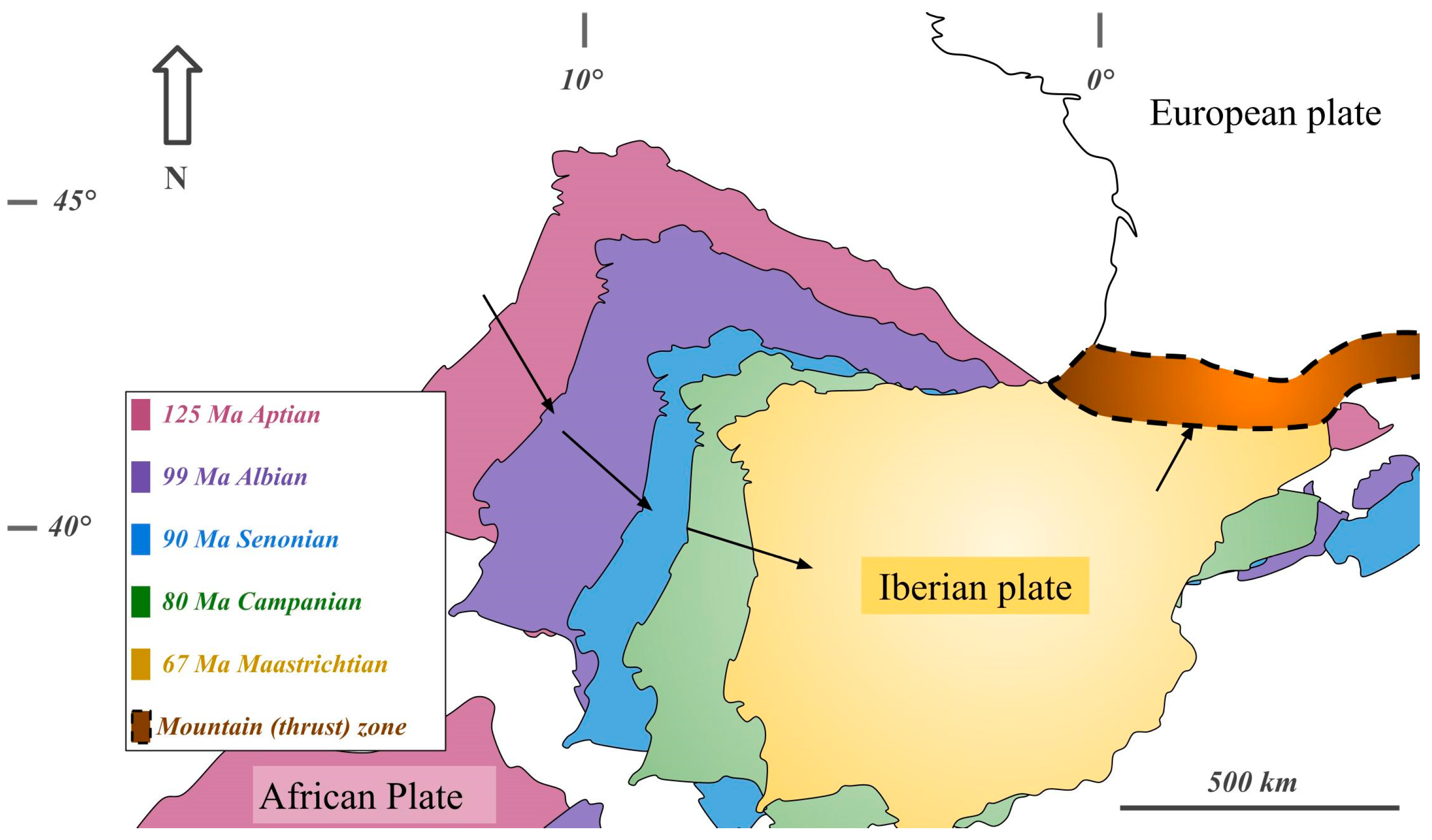
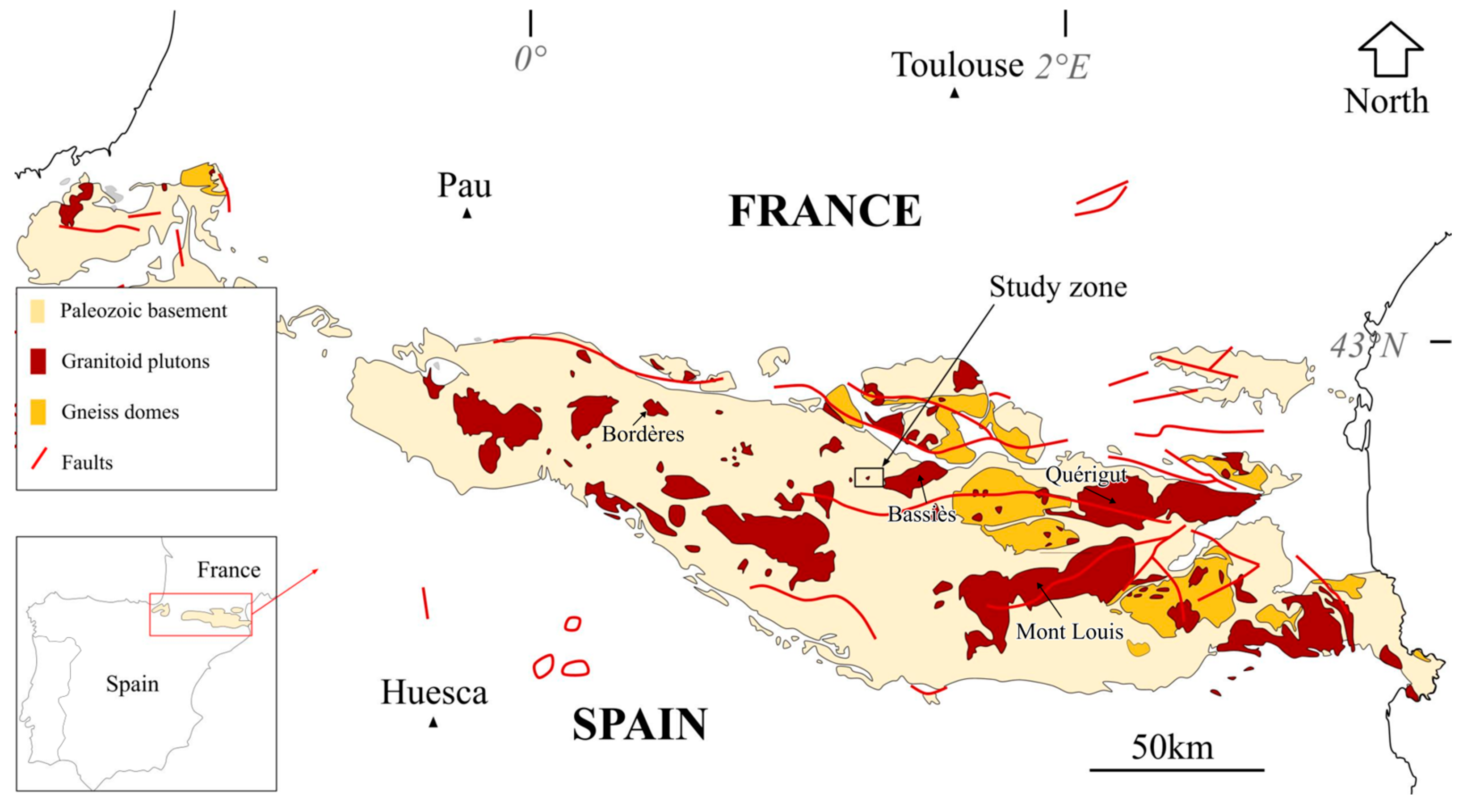

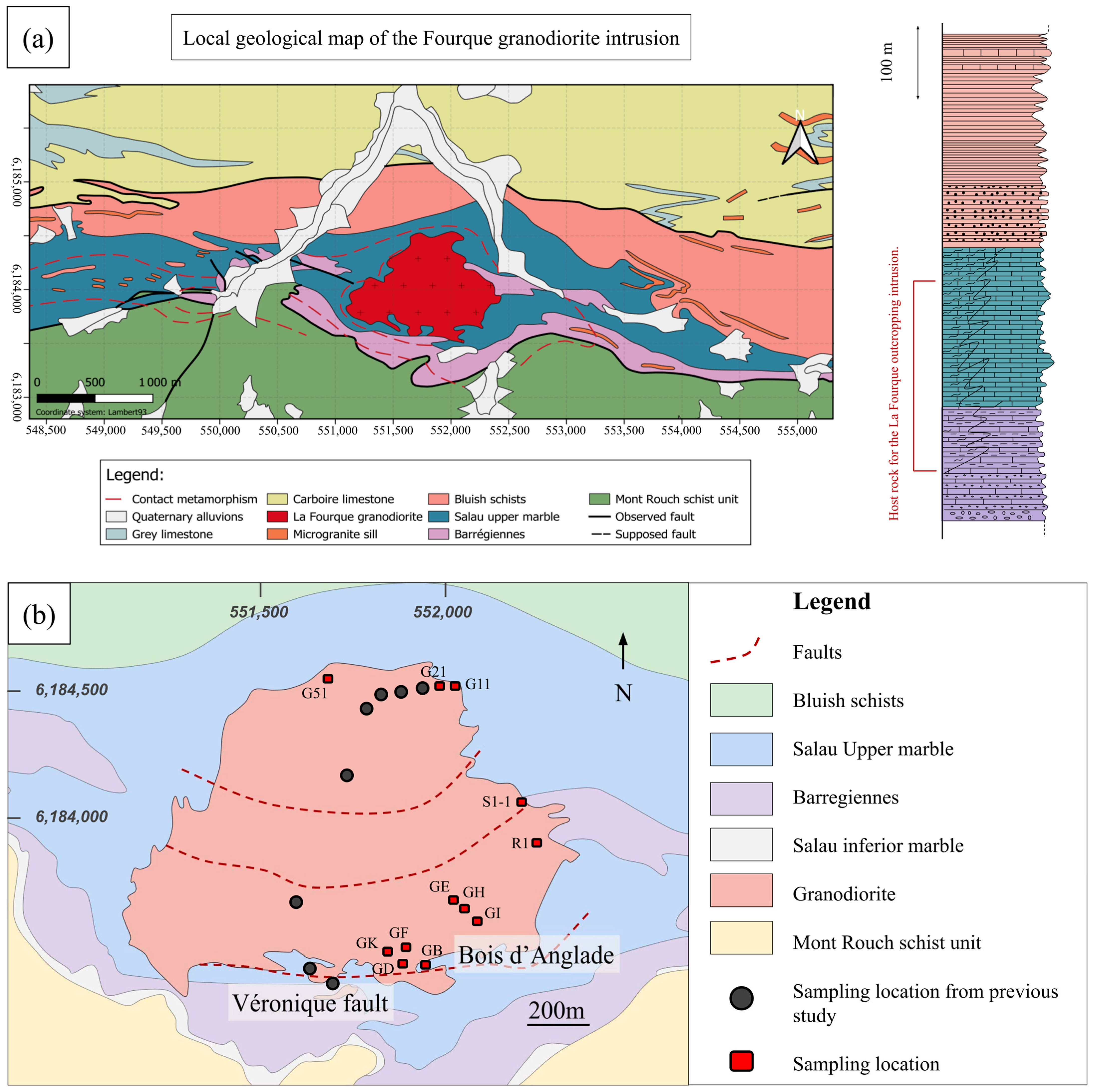


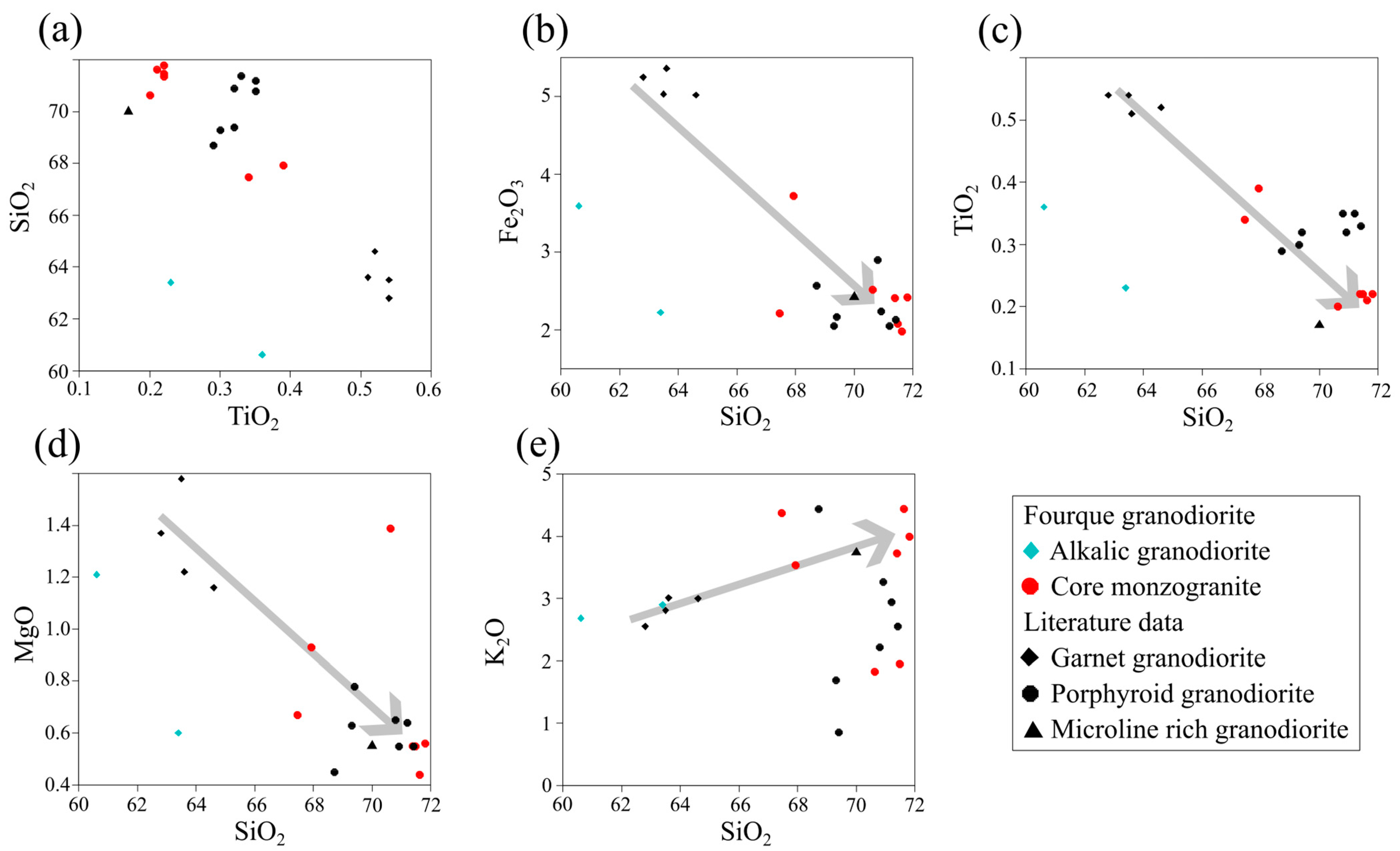

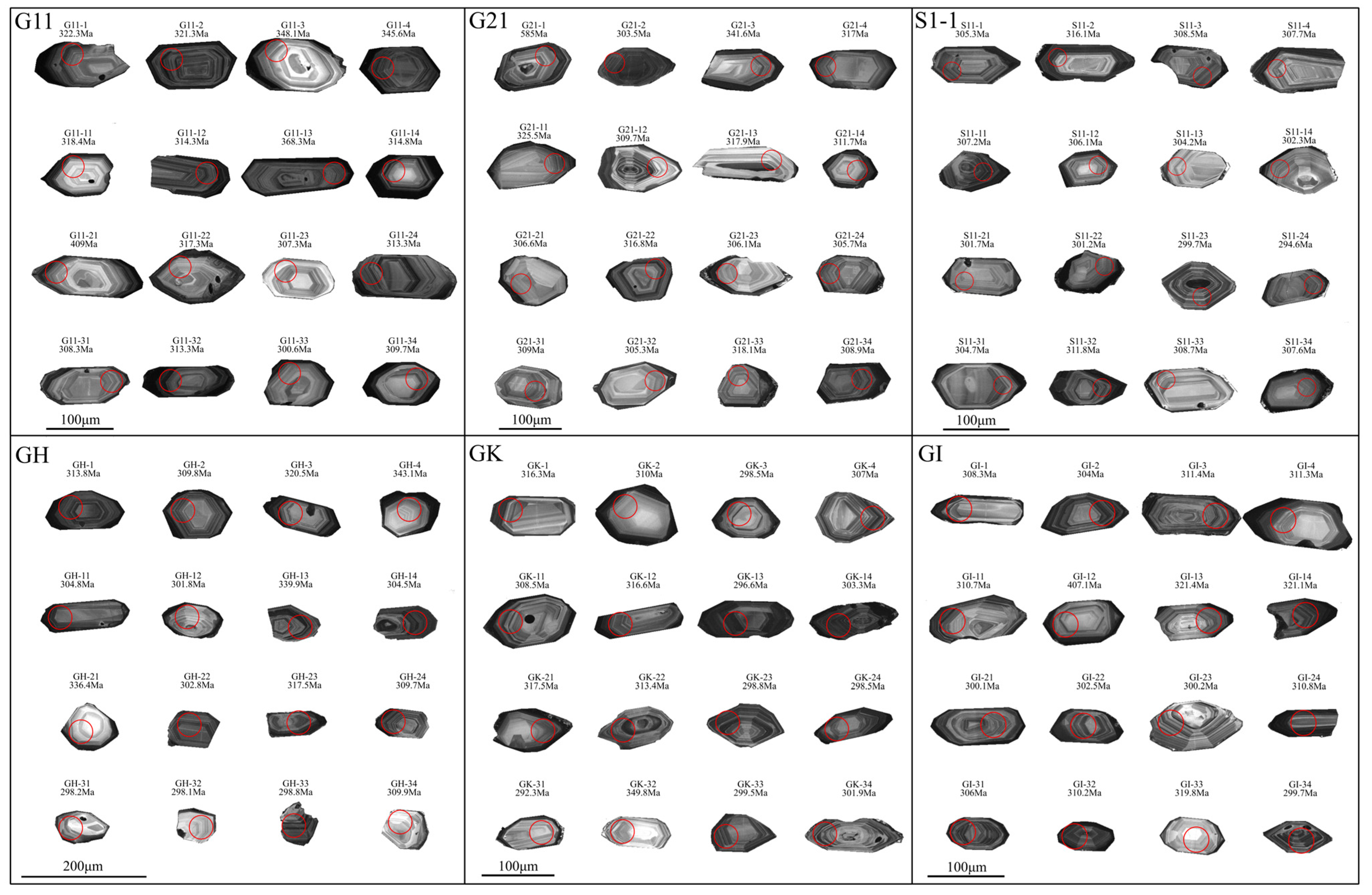

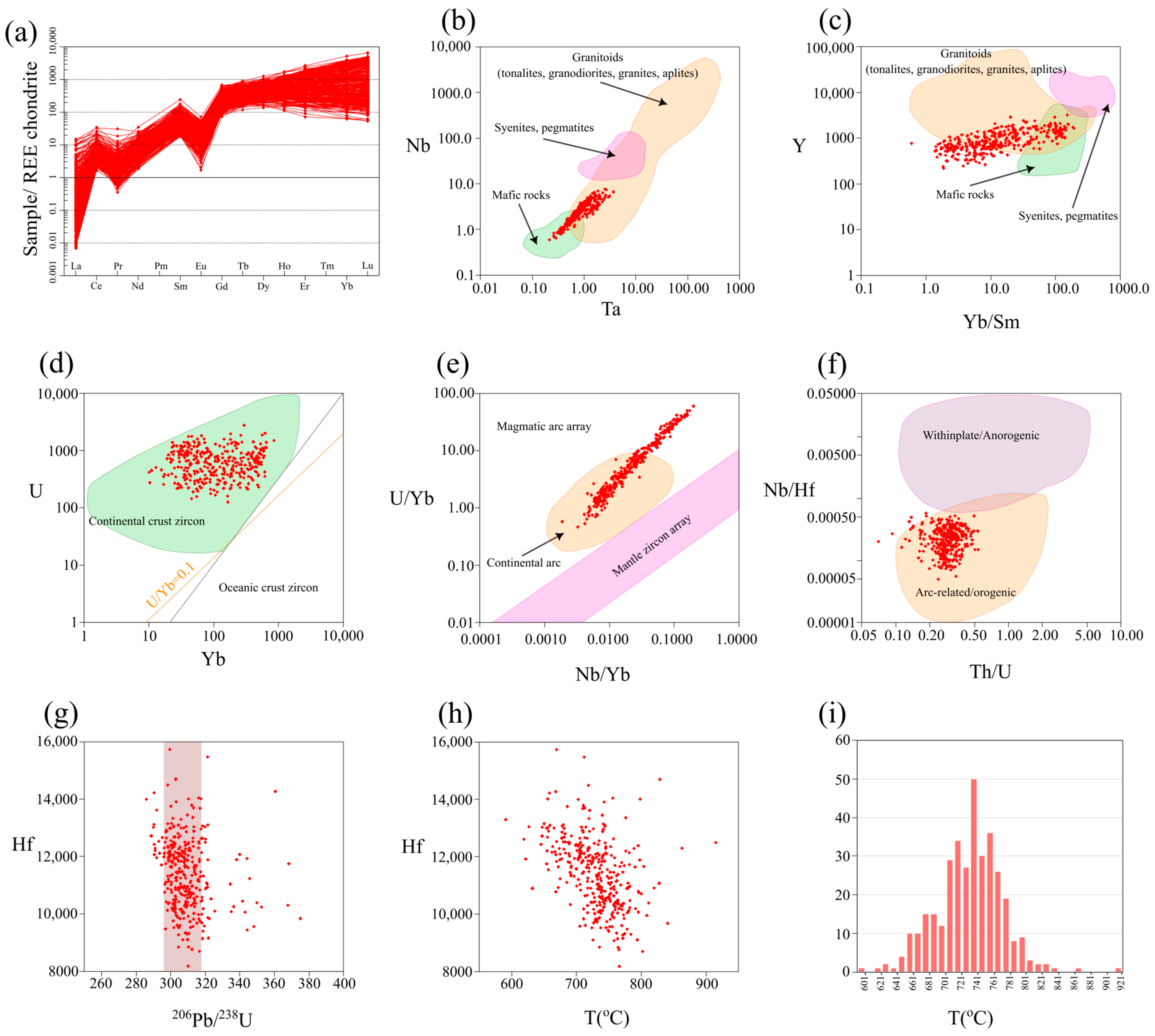
Disclaimer/Publisher’s Note: The statements, opinions and data contained in all publications are solely those of the individual author(s) and contributor(s) and not of MDPI and/or the editor(s). MDPI and/or the editor(s) disclaim responsibility for any injury to people or property resulting from any ideas, methods, instructions or products referred to in the content. |
© 2025 by the authors. Licensee MDPI, Basel, Switzerland. This article is an open access article distributed under the terms and conditions of the Creative Commons Attribution (CC BY) license (https://creativecommons.org/licenses/by/4.0/).
Share and Cite
Gonzalez, E.; Li, H. Geochemistry and Geochronology of W-Mineralized Fourque Granodiorite Intrusion, Pyrenean Axial Zone, Southern France. Minerals 2025, 15, 342. https://doi.org/10.3390/min15040342
Gonzalez E, Li H. Geochemistry and Geochronology of W-Mineralized Fourque Granodiorite Intrusion, Pyrenean Axial Zone, Southern France. Minerals. 2025; 15(4):342. https://doi.org/10.3390/min15040342
Chicago/Turabian StyleGonzalez, Eric, and Huan Li. 2025. "Geochemistry and Geochronology of W-Mineralized Fourque Granodiorite Intrusion, Pyrenean Axial Zone, Southern France" Minerals 15, no. 4: 342. https://doi.org/10.3390/min15040342
APA StyleGonzalez, E., & Li, H. (2025). Geochemistry and Geochronology of W-Mineralized Fourque Granodiorite Intrusion, Pyrenean Axial Zone, Southern France. Minerals, 15(4), 342. https://doi.org/10.3390/min15040342






